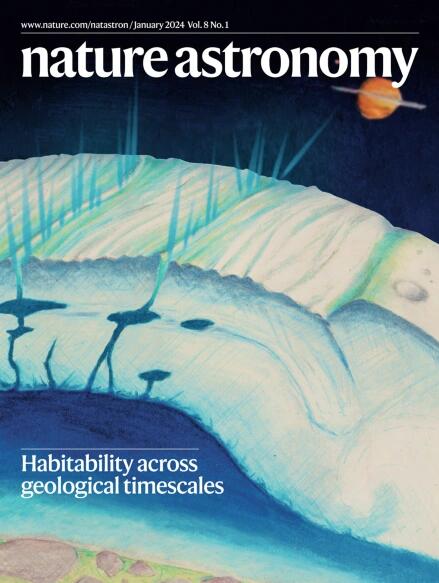A transiting giant planet in orbit around a 0.2-solar-mass host star
IF 14.3
1区 物理与天体物理
Q1 ASTRONOMY & ASTROPHYSICS
引用次数: 0
Abstract
Planet formation models indicate that the formation of giant planets is substantially harder around low-mass stars due to the scaling of protoplanetary disc masses with stellar mass. The discovery of giant planets orbiting such low-mass stars thus imposes strong constraints on giant planet formation processes. Here we report the discovery of a transiting giant planet orbiting a 0.207 ± 0.011 M⊙ star. The planet, TOI-6894 b, has a mass and radius of MP = 0.168 ± 0.022 MJ (53.4 ± 7.1 M⊕) and RP = 0.855 ± 0.022 RJ and probably includes 12 ± 2 M⊕ of metals. The discovery of TOI-6894 b highlights the need for a better understanding of giant planet formation mechanisms and the protoplanetary disc environments in which they occur. The extremely deep transits (17% depth) make TOI-6894 b one of the most accessible exoplanetary giants for atmospheric characterization observations, which will be key for fully interpreting the formation history of this notable system and for the study of atmospheric methane chemistry. Analysis of data from multiple instruments reveals a giant exoplanet in orbit around the 0.2-solar-mass star TOI-6894. The existence of this exoplanetary system challenges assumptions about planet formation and it is an excellent target for atmospheric characterization.


一颗围绕0.2太阳质量的主星运行的凌日巨行星
行星形成模型表明,由于原行星盘质量与恒星质量的比例关系,在低质量恒星周围形成巨行星要困难得多。围绕如此低质量恒星运行的巨行星的发现,因此对巨行星的形成过程施加了强烈的限制。在这里,我们报告发现了一颗绕0.207±0.011 M⊙恒星运行的凌日巨行星。这颗行星TOI-6894 b的质量和半径为MP = 0.168±0.022 MJ(53.4±7.1 M⊕),RP = 0.855±0.022 RJ,可能含有12±2 M⊕的金属。TOI-6894 b的发现强调了更好地理解巨行星形成机制和它们发生的原行星盘环境的必要性。极深的凌日(17%的深度)使TOI-6894 b成为大气特征观测最容易接近的系外行星之一,这将是全面解释这个著名系统的形成历史和研究大气甲烷化学的关键。
本文章由计算机程序翻译,如有差异,请以英文原文为准。
求助全文
约1分钟内获得全文
求助全文
来源期刊

Nature Astronomy
Physics and Astronomy-Astronomy and Astrophysics
CiteScore
19.50
自引率
2.80%
发文量
252
期刊介绍:
Nature Astronomy, the oldest science, has played a significant role in the history of Nature. Throughout the years, pioneering discoveries such as the first quasar, exoplanet, and understanding of spiral nebulae have been reported in the journal. With the introduction of Nature Astronomy, the field now receives expanded coverage, welcoming research in astronomy, astrophysics, and planetary science. The primary objective is to encourage closer collaboration among researchers in these related areas.
Similar to other journals under the Nature brand, Nature Astronomy boasts a devoted team of professional editors, ensuring fairness and rigorous peer-review processes. The journal maintains high standards in copy-editing and production, ensuring timely publication and editorial independence.
In addition to original research, Nature Astronomy publishes a wide range of content, including Comments, Reviews, News and Views, Features, and Correspondence. This diverse collection covers various disciplines within astronomy and includes contributions from a diverse range of voices.
 求助内容:
求助内容: 应助结果提醒方式:
应助结果提醒方式:


